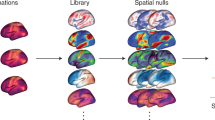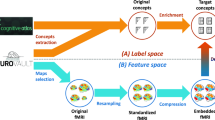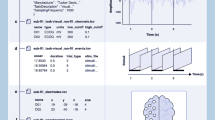Key Points
-
A spectacular explosion in the amount of available scientific data has accompanied the profound advances that we have made on our quest to understand brain function. To make better sense of all of this information, we need to develop appropriate information-management tools, such as databases. Data from neuroimaging studies are particularly suitable for databasing, and the imaging community has begun to make efforts towards the development of imaging databases.
-
The development of databases is a complex problem that has many different dimensions, from the technological to the sociological. There has been significant progress in some of these dimensions, particularly with regard to the technology that is required to create a useful database. So, there are databases of different classes; each is aimed at a specific level of analysis and serves a particular purpose. The development of appropriate tools and software, which continues to progress steadily, has accompanied the development of these databases.
-
But there are other issues that have not seen so much progress. One of these relates to the class of data that needs to be fed into the database. As it is possible to share information at different levels of processing, from raw to highly analysed data, it has been difficult to reach an agreement on the right level of sharing, and there is current debate on the pros and cons of making data publicly available. We also lack a data taxonomy that allows us to codify data in a standard format, and there are nomenclature problems that add a further level of complexity to the development of databases.
-
In addition to these problems, there are other issues that need to be addressed if databasing is to be successful. These include problems of curation and quality control (who is going to make sure that the database is maintained and that the data are of good quality?), and legal and ethical issues (how will the rights of the data producer be protected?). Until these issues have been solved, data sharing and the creation of databases will continue to be a challenging goal.
Abstract
The potential of neuroimage databases to accelerate the dissemination and use of information about brain structure and function is enormous and ever increasing. Numerous efforts are now underway to further develop the technology and sociology that are necessary to support this revolution. Each effort has its own approach and tackles some of the complex problems that are associated with creating and providing access to a database. This paper introduces many of the recent successes and future challenges that are faced by the developers and users of neuroimage databases.
This is a preview of subscription content, access via your institution
Access options
Subscribe to this journal
Receive 12 print issues and online access
$189.00 per year
only $15.75 per issue
Buy this article
- Purchase on Springer Link
- Instant access to full article PDF
Prices may be subject to local taxes which are calculated during checkout




Similar content being viewed by others
References
Toga, A. W. (ed.) Brain Warping (Academic, San Diego, 1999).This book provides a comprehensive coverage of all the approaches used in registration and spatial normalization, which are necessary for multisubject databases. The informatics methods described in this book combine research in mathematics, computer science and neuroscience.
Rogers, L. F. PACS: radiology in the digital world. AJR Am. J. Roentgenol. 177, 499 (2001).
Narr, K. L. et al. 3D mapping of gyral shape and cortical surface asymmetries in schizophrenia: gender effects. Am. J. Psychiatry 158, 244–255 (2001).
Mega, M. S. et al. Construction, testing, and validation of a sub-volume probabilistic human brain atlas for the elderly and demented populations. Neuroimage 11, S597 (2000).
Sowell, E. R., Thompson, P. M., Tessner, K. D. & Toga, A. W. Mapping continued brain growth and gray matter density reduction in dorsal frontal cortex: inverse relationships during post adolescent brain maturation. J. Neurosci. 21, 8819–8829 (2001).
Toga, A. W. Imaging databases and neuroscience. Neuroscientist (in the press).
Bowden, D. M. & Martin, R. F. NeuroNames brain hierarchy. Neuroimage 2, 63–83 (1995).
Martin, R. F. & Bowden, D. M. A stereotaxic template atlas of the macaque brain for digital imaging and quantitative neuroanatomy. Neuroimage 4, 119–150 (1996).
Fiala, J. C. & Harris, K. M. Extending unbiased stereology of brain ultrastructure to three-dimensional volumes. J. Am. Med. Inform. Assoc. 8, 1–16 (2001).
Evans, A. C. et al. in Functional Neuroimaging: Technical Foundations (eds Thatcher, R. W., Hallett, M., Zeffiro, T., John, E. R. & Huerta, M.) 145–162 (Academic, San Diego, 1994).
Thompson, J. M., Woods, R. P., Mega, M. S. & Toga, A. W. Mathematical/computational challenges in creating deformable and probabilistic atlases of the human brain. Hum. Brain Mapp. 9, 81–92 (2000).
Steinmetz, H., Furst, G. & Freund, H.-J. Cerebral cortical localization: application and validation of the proportional grid system in MR imaging. J. Comput. Assist. Tomogr. 13, 10–19 (1989).
Sowell, E. R., Thompson, P. M., Holmes, C. J., Jernigan, T. L. & Toga, A. W. In vivo evidence for post adolescent brain maturation in frontal and striated regions. Nature Neurosci. 2, 859–861 (1999).
Thompson, P. M. et al. Cortical variability and asymmetry in normal aging and Alzheimer's disease. Cereb. Cortex 8, 492–509 (1998).
Thompson, P. M. et al. Mapping adolescent brain change reveals dynamic wave of accelerated gray matter loss in very early-onset schizophrenia. Proc. Natl Acad. Sci. USA 98, 11650–11655 (2001).This paper describes a four-dimensional approach that is sensitive to dynamic events in a changing brain. Changes over time present a unique challenge to databases, but one that is crucial to understanding developing, degenerating or otherwise changing brain structure or function.
Blanton, R. E. et al. Mapping cortical asymmetry and complexity patterns in normal children. Psychiatry Res. 107, 29–43 (2001).
Paus, T. et al. Maturation of white matter in the human brain: a review of magnetic resonance studies. Brain Res. Bull. 54, 255–266 (2001).
Bloom, F. E., Young, W. G. & Kim, W. M. Brain Browser (Academic, San Diego, 1990).One of the first successful neuroanatomical databases. It was built using a readily available system on a desktop computer. It enabled the investigator to personalize the contents and use the database as an interactive digital lab notebook.
Swanson, L. W. Brain Maps: Structure of the Rat Brain (Elsevier, Amsterdam, 1992).
Toga, A. W. & Cannestra, A. F. A three dimensional multi-modality brain map of the nemistrina monkey. Soc. Neurosci. Abstr. 22, 675 (1996).
Dhenain, M., Ruffins, S. W. & Jacobs, R. E. Three-dimensional digital mouse atlas using high-resolution MRI. Dev. Biol. 232, 458–470 (2001).
Kaufman, M. H., Brune, R. M., Davidson, D. R. & Baldock, R. A. Computer-generated three-dimensional reconstructions of serially sectioned mouse embryos. J. Anat. 193, 323–336 (1998).
Nowinski, W. L., Bryan, R. N. & Raghavan, R. The Electronic Clinical Brain Atlas: Multiplanar Navigation of the Human Brain (Thieme, New York/Stuttgart, 1997).
Healy, M. D. et al. Olfactory receptor database (ORDB): resource for sharing and analysing published and unpublished data. Chem. Senses 22, 321–326 (1997).
Peterson, B. E., Healy, M. D., Nadkarni, P. M., Miller, P. L. & Shepherd, G. M. ModelDB: an environment for running and storing computational models and their results applied to neuroscience. J. Am. Med. Inform. Assoc. 3, 389–398 (1996).
Fox, P. T., Mikiten, S., Davis, G. & Lancaster, J. L. in Functional Neuroimaging: Technical Foundations (eds Thatcher, R. W., Hallett, M., Zeffiro, T., John, E. R. & Huerta, M.) 95–106 (1994).
Lancaster, J. L. et al. Automated Talairach atlas labels for functional brain mapping. Hum. Brain Mapp. 10, 120–131 (2000).
Rademacher, J., Caviness, V. S. Jr, Steinmetz, H. & Galaburda, A. M. Topographical variation of the human primary cortices: implications for neuroimaging, brain mapping and neurobiology. Cereb. Cortex 3, 313–329 (1993).The variability in the cortex described here makes it clear that simple averages are insufficient for databases. This variability must be accommodated and measured within a database for it to have value in representing a population.
Roland, P. E. & Zilles, K. Brain atlases — a new research tool. Trends Neurosci. 17, 458–467 (1994).
Talairach, J. & Tournoux, P. Co-Planar Stereotaxic Atlas of the Human Brain (Thieme Medical, New York, 1988).This is the most widely used stereotaxic atlas of the human brain. It was the first generally accepted method of achieving spatial normalization of brains from different individuals and was rapidly adopted by the brain-mapping community.
Broit, C. Optimal Registration of Deformed Images. Thesis, Univ. Pennsylvania (1981).
Bajcsy, R. & Kovacic, S. Multiresolution elastic matching. Comput. Vis. Graph. Image Process. 46, 1–21 (1989).This pioneering work showed the application of sophisticated mathematical approaches to more accurately match brains from different subjects. The local deformations used here warped different brains on the basis of pixel intensities.
Gee, J. C., Reivich, M. & Bajcsy, R. Elastically deforming an atlas to match anatomical brain images. J. Comput. Assist. Tomogr. 17, 225–236 (1993).
Gee, J. C., LeBriquer, L., Barillot, C., Haynor, D. R. & Bajcsy, R. Bayesian Approach to the Brain Image Matching Problem. Technical Report No. 95–08, Institute for Research in Cognitive Science, Univ. Pennsylvania (1995).
Thompson, P. M. & Toga, A. W. A surface-based technique for warping 3-dimensional images of the brain. IEEE Trans. Med. Imaging 15, 1–16 (1996).
Thompson, P. M. & Toga, A. W. in Brain Warping (ed. Toga, A. W.) 311–336 (Academic, San Diego, 1999).
Thompson, P. M., Woods, R. P., Mega, M. S. & Toga, A. W. Mathematical/computational challenges in creating deformable and probabilistic atlases of the human brain. Hum. Brain Mapp. 9, 81–92 (2000).
Grefkes, C., Geyer, S., Schormann, T., Roland, P. & Zilles, K. Human somatosensory area 2: observer-independent cytoarchitectonic mapping, interindividual variability, and population map. Neuroimage 14, 617–631 (2001).
Bookstein, F. Principal warps: thin-plate splines and the decomposition of deformations. IEEE Trans. Pattern Anal. Mach. Intell. 11, 567–585 (1989).
Bookstein, F. L. Landmark methods for forms without landmarks: morphometrics of group differences in outline shape. Med. Image Anal. 1, 225–243 (1997).
Davatzikos, C. et al. A computerized approach for morphological analysis of the corpus callosum. J. Comput. Assist. Tomogr. 20, 88–97 (1996).
Subsol, G., Roberts, N., Doran, M., Thirion, J. P. & Whitehouse, G. H. Automatic analysis of cerebral atrophy. Magn. Reson. Imaging 15, 917–927 (1997).
Thompson, P. M. & Toga, A. W. Detection, visualization and animation of abnormal anatomic structure with a deformable probabilistic brain atlas based on random vector field transformations. Med. Image Anal. 1, 271–294 (1997).
Thompson, P. M. et al. Detection and mapping of abnormal brain structure with a probabilistic atlas of cortical surfaces. J. Comput. Assist. Tomogr. 21, 567–581 (1997).
Grenander, U. & Miller, M. I. Computational Anatomy: an Emerging Discipline. Technical Report, Department of Mathematics, Brown Univ. (1998).
Davatzikos, C. Spatial transformation and registration of brain images using elastically deformable models. Comput. Vis. Image Underst. 66, 207–222 (1997).
Toga, A. W., Thompson, P. M. & Payne, B. A. in Developmental Neuroimaging: Mapping the Development of Brain and Behavior (eds Thatcher, R. W., Lyon, G. R., Rumsey, J. & Krasnegor, N.) 15–27 (Academic, San Diego, 1996).
Mazziotta, J. et al. A four-dimensional probabilistic atlas of the human brain. J. Am. Med. Inform. Assoc. 8, 401–430 (2001).
Mazziotta, J. et al. A probabilistic atlas and reference system for the human brain: International Consortium for Brain Mapping (ICBM). Phil. Trans. R. Soc. Lond. B 356, 1293–1322 (2001).
Toga, A. W., Rex, D. E. & Ma, J. A graphical interoperable processing pipeline. Neuroimage Abstr. 13, S266 (2001).
Fox, P. T. & Lancaster, J. L. Mapping context and content: the BrainMap model. Nature Rev. Neurosci. 3, 319–321 (2002).
Van Horn, J. D. & Gazzaniga, M. S. Databasing fMRI studies — towards a 'discovery science' of brain function. Nature Rev. Neurosci. 3, 314–318 (2002).
Rennie, D., Yank, V. & Emanuel, L. When authorship fails — a proposal to make contributors accountable. JAMA 278, 579–585 (1997).
Acknowledgements
This work was generously supported by research grants from the National Library of Medicine, the National Center for Research Resources, and by a Human Brain Project grant known as the International Consortium for Brain Mapping, which is funded jointly by the National Institute of Mental Health and the National Institute on Drug Abuse. The author also wishes to acknowledge his deep appreciation to the members of the Laboratory of Neuro Imaging and, especially, J. Bacheller and A. Lee for their graphical prowess.
Author information
Authors and Affiliations
Related links
Related links
FURTHER INFORMATION
Directive 96/9/EC on the legal protection of databases
Encyclopedia of Life Sciences
brain imaging: localization of brain functions
brain imaging: observing ongoing neural activity
ethics of research: protection of human subjects
International Consortium for Brain Mapping
Laboratory of Neuro Imaging (LONI)
MIT Encyclopedia of Cognitive Sciences
NLM's Unified Medical Language System
Statement on H.R. 354 — the Collections of Information Antipiracy Act
Glossary
- BOOLEAN LOGIC
-
Named after the nineteenth-century mathematician George Boole, Boolean logic is a form of algebra in which all values are reduced to either true or false. Boolean logic is especially important for computer science because it fits nicely with its binary numbering system. Boolean logic depends on the use of three logical operators, AND, OR and NOT.
- FUZZY LOGIC
-
A type of logic that recognizes more than true and false values. Propositions can be represented with degrees of truth and untruth. This characteristic of fuzzy logic has made it particularly useful in the field of artificial intelligence.
- TALAIRACH SYSTEM
-
In 1988, Talairach and Tournoux published a stereotaxic atlas of the human brain that introduced three important innovations: a coordinate system to identify a particular brain location relative to anatomical landmarks; a spatial transformation to match one brain to another; and an atlas that describes a standard brain, with anatomical and cytoarchitectonic labels. The authors suggested that the brain be aligned according to the anterior and posterior commissures, two relatively invariant structures. The experimenter draws a line between the commissures and rotates the brain so that this line is on a horizontal plane. According to the Talairach system, a coordinate can now be defined relative to three orthogonal axes, with the anterior commissure as the origin.
- PULSE SEQUENCE
-
A set of radiofrequency pulses that are applied to a sample to produce a specific form of nuclear magnetic resonance signal.
- ONTOLOGY
-
The specification of unique relationships between words and the operationally defined concepts they represent. A neuroanatomical ontology defines the relations of neuroanatomical terms to structures in the brain.
- MAGNETOENCEPHALOGRAPHY
-
A non-invasive technique that allows the detection of the changing magnetic fields that are associated with brain activity. As the magnetic fields of the brain are very weak, extremely sensitive magnetic detectors known as superconducting quantum interference devices, which work at very low, superconducting temperatures (−269 °C), are used to pick up the signal.
Rights and permissions
About this article
Cite this article
Toga, A. Neuroimage databases: The good, the bad and the ugly. Nat Rev Neurosci 3, 302–309 (2002). https://doi.org/10.1038/nrn782
Issue Date:
DOI: https://doi.org/10.1038/nrn782
This article is cited by
-
Data Archive for the BRAIN Initiative (DABI)
Scientific Data (2023)
-
Integrating radiomics into holomics for personalised oncology: from algorithms to bedside
European Radiology Experimental (2020)
-
Personal medicine—the new banking crisis
Nature Biotechnology (2012)
-
Do brain image databanks support understanding of normal ageing brain structure? A systematic review
European Radiology (2012)
-
The Cognitive Paradigm Ontology: Design and Application
Neuroinformatics (2012)



